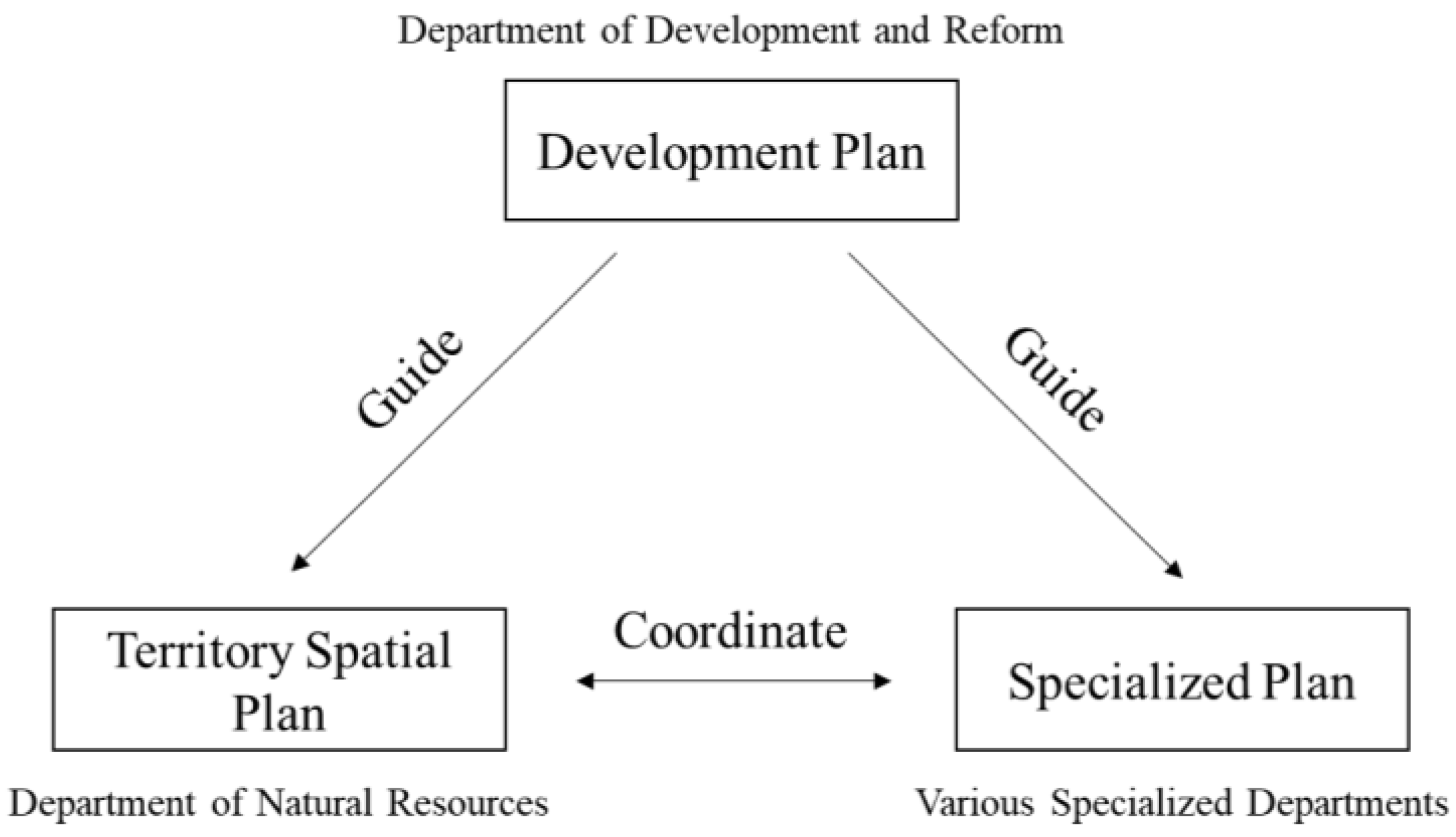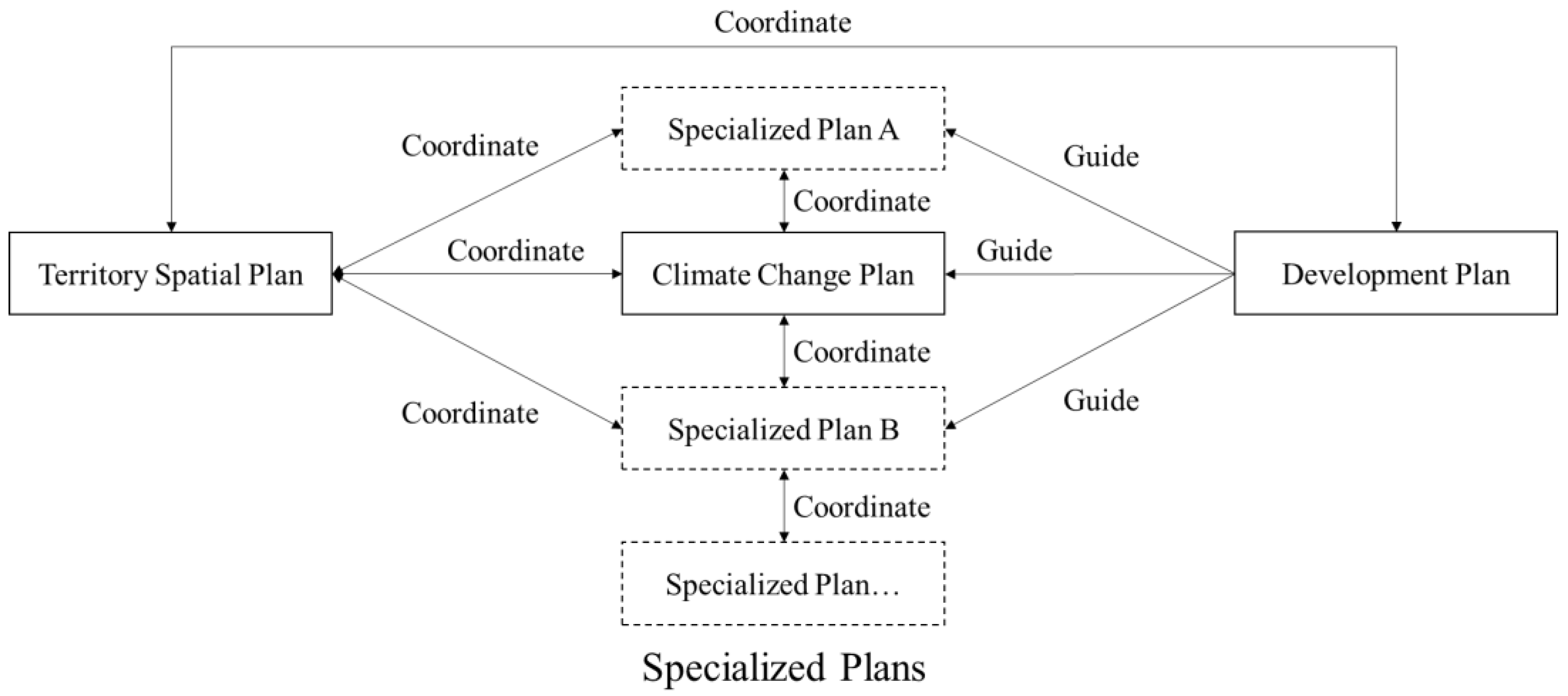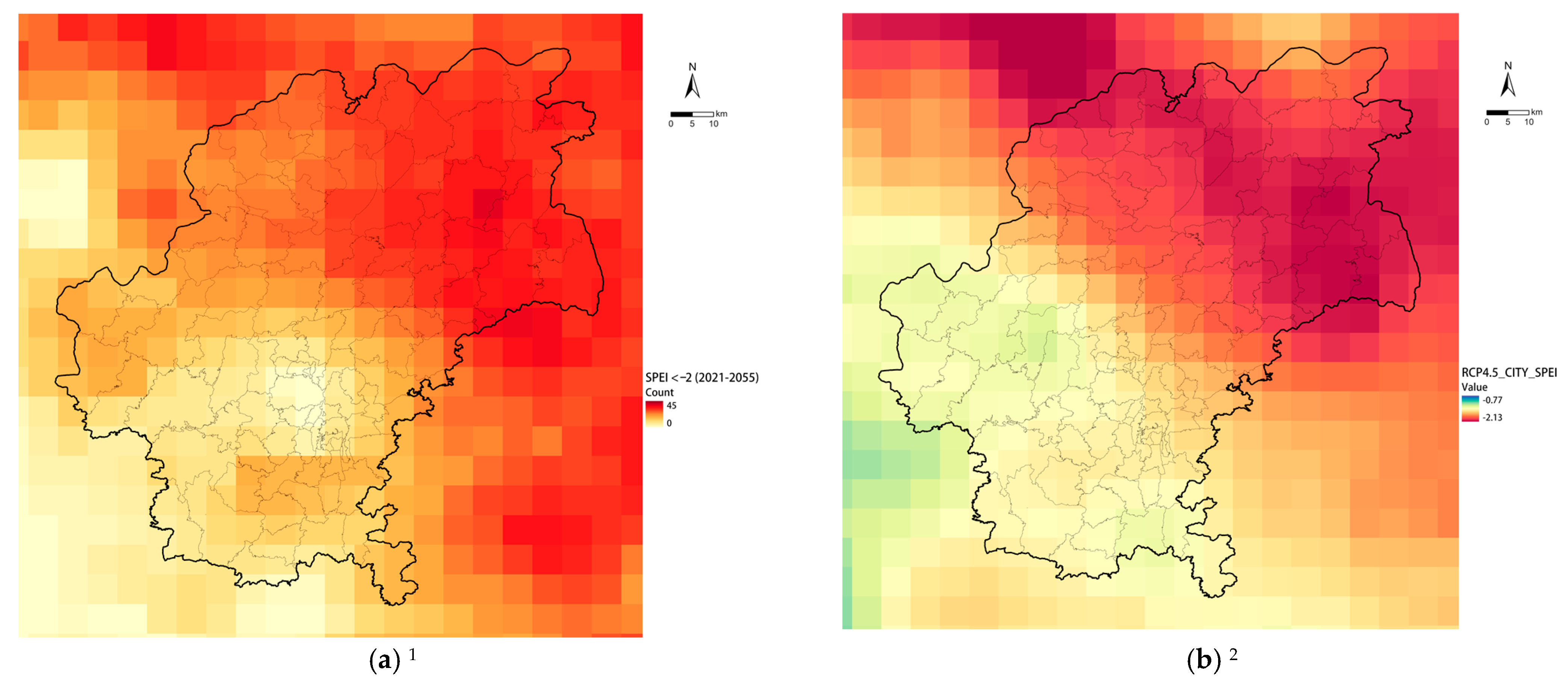Implementing Climate Change Adaptation in Territory Spatial Planning Systems: Challenges and Approaches Based on Practices in Guiyang
Abstract
1. Introduction
1.1. SDG13: Climate Action and Spatial Planning
1.2. Climate Change Impacts on China
1.3. China’s Climate Change Strategy
1.4. Established Studies and Backgrounds
2. Reviews of China’s Planning Systems Related to Climate Change
2.1. Relevant Planning Systems and the Relational Structure for Climate Adaptation in China’s National Planning Systems
2.1.1. Development Plans
2.1.2. Specialized Plans
2.2. Climate Change Plan
2.2.1. System Structure of Climate Change Plan: Compilation and Implementation
2.2.2. National and Provincial Plan
2.2.3. Prefectural Plan
2.3. Territory Spatial Planning
2.3.1. System Structure of TSPS
2.3.2. Climate Change Adaptation in the System
2.3.3. Objectives for Territory Spatial Planning on Adaptation Set by the National Strategy
3. Materials and Methods
3.1. Case Study Area and Current Spatial Planning
3.2. Methodology
3.3. Adaptation Planning Framework
3.4. Major Defects in Planning Process
3.4.1. Deficiency of Climate Change Impact Analyses in Planning Areas
3.4.2. Absence of Transmission Tools between Adaptation Strategies and Tactics
3.4.3. The Inability of Current Spatial Planning System to Integrate Adaptation Actions
4. Results
4.1. Approach/Objective-Action Framework
4.2. Efficient Evaluation: Improve the Assessment Accuracy of Climate Change Impacts across TSPS and Relevant Planning Systems
4.2.1. Enhance Cross-Sectoral Coordination with the Meteorological Sector
4.2.2. Build and Provide Accessible Climate Change Assessment Tools for Planners
4.3. Formulating a Strategy Framework for Adaptation in TSPS
4.3.1. Mirror Existing International Experiences
4.3.2. Launch Pilot Projects and Summarize Feedback
4.4. Policy for Spatial Planning: Integrating Adaptation Actions through Spatial Planning and Corresponding Regulatory Legislation
4.4.1. Develop Adaptation-Associated Land-Use Policy System on Multiple Levels
4.4.2. Compose Guidelines for Planning Implementation of Climate Change Adaptation Actions
5. Discussion and Conclusions
5.1. Enhance the Pertinence of Territory Spatial Planning
5.2. Advance the Implementation of Territory Spatial Planning
5.3. Strengthen Stakeholders’ Engagement
5.4. Limitations
5.5. Conclusions
Author Contributions
Funding
Institutional Review Board Statement
Informed Consent Statement
Data Availability Statement
Acknowledgments
Conflicts of Interest
References
- Arias, P.A.; Bellouin, N.; Coppola, E.; Jones, R.G.; Krinner, G.; Marotzke, J.; Naik, V.; Palmer, M.D.; Plattner, G.-K.; Rogelj, J.; et al. Technical Summary. In Climate Change 2021: The Physical Science Basis; Masson-Delmotte, V., Zhai, A.P., Pirani, S.L., Connors, C., Péan, S., Berger, N., Caud, Y., Chen, L., Goldfarb, M.I., Gomis, M., et al., Eds.; Cambridge University Press: Cambridge, UK; New York, NY, USA, 2021; pp. 33–144. [Google Scholar] [CrossRef]
- World Commission on Environment and Development. Our Common Future; Oxford University Press: Oxford, UK, 1990; pp. 147–150. ISBN 978-019-282-080-8. [Google Scholar]
- Annual 2020 Global Climate Report. Available online: https://www.ncei.noaa.gov/access/monitoring/monthly-report/global/202013 (accessed on 3 June 2022).
- Sustainable Development Goals|United Nations Development Programme. Available online: https://www.undp.org/sustainable-development-goals (accessed on 3 June 2022).
- Fonseca, L.M.; Domingues, J.P.; Dima, A.M. Mapping the Sustainable Development Goals Relationships. Sustainability 2020, 12, 3359. [Google Scholar] [CrossRef]
- Wilson, E. Adapting to Climate Change at the Local Level: The Spatial Planning Response. Local Environ. 2006, 11, 609–625. [Google Scholar] [CrossRef]
- Mizutori, M.; Guha-Sapir, D. The Human Cost of Disasters: An Overview of the Last 20 Years (2000–2019). Available online: https://www.preventionweb.net/files/74124_humancostofdisasters20002019reportu.pdf (accessed on 3 June 2022).
- Gao, X.; Shi, Y.; Zhang, D.; Giorgi, F. Climate change in China in the 21st century as simulated by a high resolution regional climate model. Chin. Sci. Bull. 2012, 57, 1188–1195. [Google Scholar] [CrossRef]
- National Development and Reform Commission, China. 12th Five-Year Plan (2011–2015) for National Economic and Social Development. Available online: http://www.gov.cn/2011lh/content_1825838.htm (accessed on 3 June 2022).
- National Development and Reform Commission, China. National Plan on Climate Change 2014-2020. Available online: http://www.scio.gov.cn/xwfbh/xwbfbh/wqfbh/33978/35364/xgzc35370/Document/1514527/1514527.htm (accessed on 3 June 2022).
- He, X. Information on Impacts of Climate Change and Adaptation in China. J. Environ. Inform. 2017, 29, 110–121. [Google Scholar] [CrossRef]
- Ministry of Ecology and Environment, People´s Republic of China. National Climate Change Adaptation Strategy 2035. Available online: https://www.mee.gov.cn/xxgk2018/xxgk/xxgk03/202206/W020220613636562919192.pdf (accessed on 3 June 2022).
- Biesbroek, G.R.; Swart, R.J.; van der Knaap, W.G.M. The mitigation–adaptation dichotomy and the role of spatial planning. Habitat. Int. 2009, 33, 230–237. [Google Scholar] [CrossRef]
- Hurlimann, A.; March, A. The role of spatial planning in adapting to climate change. WIREs. Clim. Change 2012, 3, 477–488. [Google Scholar] [CrossRef]
- Greiving, S.; Fleischhauer, M. National Climate Change Adaptation Strategies of European States from a Spatial Planning and Development Perspective. Eur. Plan. Stud. 2012, 20, 27–48. [Google Scholar] [CrossRef]
- Macintosh, A.; Foerster, A.; McDonald, J. Policy design, spatial planning and climate change adaptation: A case study from Australia. J. Environ. Plan. Manag. 2015, 58, 1432–1453. [Google Scholar] [CrossRef]
- Schmidt-Thomé, P.; Klein, J. Applying Climate Change Adaptation in Spatial Planning Processes. In Global Change and Baltic Coastal Zones; Schernewski, G., Hofstede, J., Neumann, T., Eds.; Springer: Dordrecht, The Netherlands, 2011; pp. 177–192. ISBN 978-94-007-0399-5. [Google Scholar]
- Dhar, T.K.; Khirfan, L. Climate change adaptation in the urban planning and design research: Missing links and research agenda. J. Environ. Plan. Manag. 2017, 60, 602–627. [Google Scholar] [CrossRef]
- Luo, X.; Yu, C.W.; Zhou, D.; Gu, Z. Challenges and adaptation to urban climate change in China: A viewpoint of urban climate and urban planning. Indoor. Built. Environ. 2019, 28, 1157–1161. [Google Scholar] [CrossRef]
- National Development and Reform Commission, People´s Republic of China. 14th Five-Year Plan for National Economic and Social Development and the Outline of Vision 2035. Available online: https://www.ndrc.gov.cn/xxgk/zcfb/ghwb/202103/P020210323538797779059.pdf (accessed on 3 June 2022).
- Heilmann, S.; Melton, O. The Reinvention of Development Planning in China, 1993–2012. Mod. China 2013, 39, 580–628. [Google Scholar] [CrossRef]
- White Paper on China’s Policies and Actions to Address Climate Change. Available online: http://www.gov.cn/zhengce/2021-10/27/content_5646697.htm (accessed on 3 June 2022).
- Fu, L.; Cao, Y.; Kuang, S.; Guo, H. Index for climate change adaptation in China and its application. Adv. Clim. Chang. Res. 2021, 12, 723–733. [Google Scholar] [CrossRef]
- Li, C.; Song, Y. Government response to climate change in China: A study of provincial and municipal plans. J. Environ. Plan. Manag. 2016, 59, 1679–1710. [Google Scholar] [CrossRef]
- Department of Ecology and Environment of Guangdong Province. 14th Five-Year Specialized Plan for Climate Change of Guangdong Province. Available online: http://gdee.gd.gov.cn/attachment/0/494/494368/3977041.pdf (accessed on 8 August 2022).
- Office of Hainan Province Leading Group to Address Climate Change and Energy Conservation and Emission Reduction. 14th Five-Year Plan for Climate Change of Hainan Province; Department of Ecology and Environment of Hainan Province: Haikou, China, 2022. [Google Scholar]
- Development and Reform Commission of Shenzhen. 13th Five-Year Specialized Plan for Climate Change of Shenzhen. Available online: https://www.ccchina.org.cn/archiver/ccchinacn/UpFile/Files/Htmleditor/202007/20200716085516312.doc (accessed on 3 June 2022).
- Li, B. Governing urban climate change adaptation in China. Environ. Urban 2013, 25, 413–427. [Google Scholar] [CrossRef]
- Opinions of the CPC Central Committee and the State Council on Establishing a National Territory Spatial Planning System with Its Supervision and Implementation. Available online: http://en.planning.org.cn/planning/view?id=440 (accessed on 3 June 2022).
- Yang, F.; Zong, L.; Shen, J.L.; Liu, L.F. Scientific rational orientation and decision-making support orientation: The thinking of “Double Evaluation” and territorial spatial planning. J. Nat. Resour. 2020, 35, 2311–2324. [Google Scholar] [CrossRef]
- Ministry of Natural Resources, China. Guidelines for the Preparation of Provincial Territory Spatial Planning (Trial Version). Available online: http://gi.mnr.gov.cn/202001/P020200120642346540184.pdf (accessed on 3 June 2022).
- Ministry of Natural Resources, China. Guidelines for the Preparation of Prefectural Master Territory Spatial Planning (Trial Version, Draft for Comments). Available online: http://m.mnr.gov.cn/gk/ghjh/202008/P020200820547720783027.pdf (accessed on 3 June 2022).
- Department of Natural Resources of Shandong Province. Shandong Territory Spatial Planning 2021–2035 (Draft for Comments). Available online: http://www.shandong.gov.cn/module/download/downfile.jsp?classid=0&filename=6eb8169099ab4ab68a0770de8f509b83.pdf (accessed on 3 June 2022).
- Department of Natural Resources of Sichuan Province. Sichuan Territory Spatial Planning 2020–2035 (Draft, Public Version). Available online: https://www.cqn.com.cn/fangchan/att/2021-06/15/83b48f7b-b216-450a-bc8a-6a75eb5940bc.pdf (accessed on 3 June 2022).
- Guiyang Municipal People’s Government. Guiyang City Master Plan 2011–2020; Guiyang Municipal People’s Government: Guiyang, China, 2017.
- Guiyang Municipal People’s Government. Guiyang Land Use Master Plan 2006–2020. Available online: http://g.mnr.gov.cn/201807/P020180729346510236865.wps (accessed on 3 June 2022).
- Luo, Y.; Tian, M.; Wu, H.; Wang, C.; Zhang, J. Analysis of spatial and temporal distribution of agricultural droughts and climatic background in Guizhou. Agric. Jilin 2019, 10, 108–111. [Google Scholar] [CrossRef]
- Yao, Z.; Li, Y.; Wang, J. The relationship between “Duanwu Water” and early summer precipitation of Guiyang. Adv. Meteorol. Sci. Technol. 2019, 9, 56–59. [Google Scholar]
- Weng, L.; Wu, Y.; Luo, Y. Analysis of the suitability of Guiyang’s climate for tourism and leisure. J. Green. Sci. Technol. 2020, 11, 193–196. [Google Scholar] [CrossRef]
- Beguería, S.; Vicente-Serrano, S.M.; Reig, F.; Latorre, B. Standardized precipitation evapotranspiration index (SPEI) revisited: Parameter fitting, evapotranspiration models, tools, datasets and drought monitoring. Int. J. Climatol. 2014, 34, 3001–3023. [Google Scholar] [CrossRef]
- Zhang, Q.; Kobayashi, Y.; Alipalo, M.; Zheng, Y. Strengthen Risk Management, Cope with Persistent Drought; Asian Development Bank: Mandaluyong City, Philippines, 2012; pp. 9–11. ISBN 978-92-9092-662-7. [Google Scholar]
- Ministry of Natural Resources, China. Guidelines for the Classification of Territory Spatial Land and Sea Use for Survey, Planning, and Regulation (Trial Version). Available online: https://search.mnr.gov.cn/axis2/download/P020201120539337821122.pdf (accessed on 3 June 2022).
- Department of Natural Resources of Guizhou Province. Guizhou Territory Spatial Planning 2021–2035 (Draft for Comments). Available online: https://www.guiyang.gov.cn/IGI/upload/file/2021/07/14/20210714055606130TEd.pdf (accessed on 3 June 2022).
- Goosen, H.; de Groot-Reichwein, M.A.M.; Masselink, L.; Koekoek, A.; Bessembinder, J.; Witte, J.M.P.; Stuyt, L.; Blom-Zandstra, G.; Immerzeel, W. Climate Adaptation Services for the Netherlands: An operational approach to support spatial adaptation planning. Reg. Environ. Change 2014, 14, 1035–1048. [Google Scholar] [CrossRef]
- Bremer, S.; Wardekker, A.; Dessai, S.; Sobolowski, S.; Slaattelid, R.; van der Sluijs, J. Toward a multi-faceted conception of co-production of climate services. Clim. Serv. 2019, 13, 42–50. [Google Scholar] [CrossRef]
- The California Governor’s Office of Emergency Services. California Adaptation Planning Guide. Available online: https://www.caloes.ca.gov/wp-content/uploads/Hazard-Mitigation/Documents/CA-Adaptation-Planning-Guide-FINAL-June-2020-Accessible.pdf (accessed on 3 June 2022).
- Fu, L.; Yang, X.; Zhang, D.; Cao, Y. Assessment of Climate-Resilient City Pilots in China. Chn. J. Urb. Environ. Stud. 2021, 9, 2150005:1–2150005:16. [Google Scholar] [CrossRef]
- Meresa, H.; Murphy, C.; Fealy, R.; Golian, S. Uncertainties and their interaction in flood hazard assessment with climate change. Hydrol. Earth Syst. Sci. 2021, 25, 5237–5257. [Google Scholar] [CrossRef]
- Ren, C.; Spit, T.; Lenzholzer, S.; Yim, H.L.S.; Heusinkveld, B.; van Hove, B.; Chen, L.; Kupski, S.; Burghardt, R.; Katzschner, L. Urban Climate Map System for Dutch spatial planning. Int. J. Appl. Earth Obs. Geoinf. 2012, 18, 207–221. [Google Scholar] [CrossRef]










| Region (County/District/City) | Meteorological Drought Risk Impacts | Major Adaptation Measures |
|---|---|---|
| Xifeng, Kaiyang | High | Expand irrigation systems, improve water distribution systems, and water treatment facilities, construct and renovate diversion canals to increase irrigation area and build small water storage facilities 1 |
| Xiuwen, Wudang | Medium | Transform sloping farmland to enhance water conservation, conduct ecological restoration, increase vegetation cover ratio to reduce soil erosion |
| Nanming, Yunyan, Guangshanhu, Huaxi, Baiyun, Qingzhen | Low | Repair water transmission networks to reduce leakage losses, construct water-saving facilities, and improve the water-saving capacity of completed projects |
Disclaimer/Publisher’s Note: The statements, opinions and data contained in all publications are solely those of the individual author(s) and contributor(s) and not of MDPI and/or the editor(s). MDPI and/or the editor(s) disclaim responsibility for any injury to people or property resulting from any ideas, methods, instructions or products referred to in the content. |
© 2022 by the authors. Licensee MDPI, Basel, Switzerland. This article is an open access article distributed under the terms and conditions of the Creative Commons Attribution (CC BY) license (https://creativecommons.org/licenses/by/4.0/).
Share and Cite
Zong, L.; Yang, F.; Pei, X. Implementing Climate Change Adaptation in Territory Spatial Planning Systems: Challenges and Approaches Based on Practices in Guiyang. Int. J. Environ. Res. Public Health 2023, 20, 490. https://doi.org/10.3390/ijerph20010490
Zong L, Yang F, Pei X. Implementing Climate Change Adaptation in Territory Spatial Planning Systems: Challenges and Approaches Based on Practices in Guiyang. International Journal of Environmental Research and Public Health. 2023; 20(1):490. https://doi.org/10.3390/ijerph20010490
Chicago/Turabian StyleZong, Li, Fan Yang, and Xinsheng Pei. 2023. "Implementing Climate Change Adaptation in Territory Spatial Planning Systems: Challenges and Approaches Based on Practices in Guiyang" International Journal of Environmental Research and Public Health 20, no. 1: 490. https://doi.org/10.3390/ijerph20010490
APA StyleZong, L., Yang, F., & Pei, X. (2023). Implementing Climate Change Adaptation in Territory Spatial Planning Systems: Challenges and Approaches Based on Practices in Guiyang. International Journal of Environmental Research and Public Health, 20(1), 490. https://doi.org/10.3390/ijerph20010490








